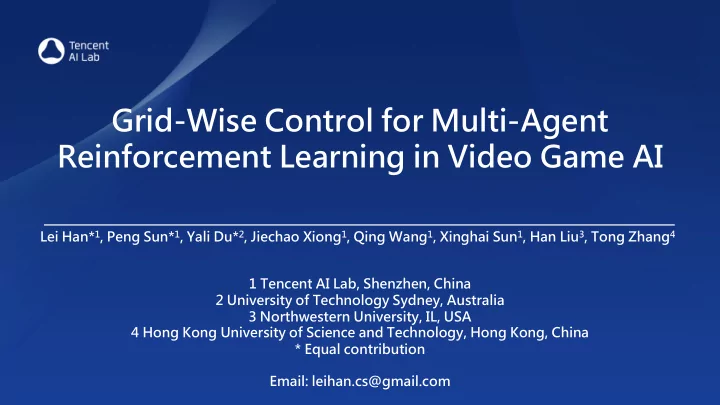

Grid-Wise Control for Multi-Agent Reinforcement Learning in Video Game AI Lei Han* 1 , Peng Sun* 1 , Yali Du* 2 , Jiechao Xiong 1 , Qing Wang 1 , Xinghai Sun 1 , Han Liu 3 , Tong Zhang 4 1 Tencent AI Lab, Shenzhen, China 2 University of Technology Sydney, Australia 3 Northwestern University, IL, USA 4 Hong Kong University of Science and Technology, Hong Kong, China * Equal contribution Email: leihan.cs@gmail.com
Introduction q Considered Problem • Multi-agent reinforcement learning (MARL) • Grid-world environment (video game) • Challenge Ø flexibly control an arbitrary number of agents Ø while achieving effective collaboration q Existing MARL Approaches • Decentralized learning Ø IQL, IAC (Tan, 1993; Foerster et al., 2017) • Centralized learning Ø CommNet, BicNet (Sukhbaatar et al., 2016; Peng et al., 2017) • Mixture Ø COMA, QMIX, Mean-Field (Foerster et al., 2017; Rashid et al., 2018; Yang et al., 2018) v Unable/instable to deal with variant agent number
GridNet q Architecture • Encoder • Decoder Ø Inputs are represented as an image-like structure Ø Up-sampling to construct an action map Ø An agent will take the action in the grid it occupies Ø Using conv/pooling layers to generate an embedding
GridNet q Algorithms • Can be integrated with many general RL algorithms Ø Q-learning Ø Actor-critic q Properties • Collaboration is natural Ø Stacked convolutional and/or pooling layers provide a large receptive field Ø Each agent is aware of other agents in its neighborhood • Fast parallel exploration Ø Convolutional parameters are shared by all the agents Ø Once an agent takes a beneficial action during its own exploration, the other agents will acquire the knowledge as well • Transferrable policy Ø The trained policy is easy to be transferred to other settings with a various number of agents
Experiments on Battle Games in StarCraft II q Scenarios • 5Immortals vs. 5Immortals ( 5I ) • 3Immortals+2Zealots vs. 3Immortals+2Zealots ( 3I2Z ) • mixed army battle ( MAB ) with a random number of various Zerg units • including Baneling, Zergling, Roach, Hydralisk and Mutalisk. q Training Strategies • Against handcraft policies: random (Rand) , attack-nearest (AN) , hit-and-run (HR) • Against self historic versions: self-play (SP) q Compared Methods • IQL : independent Q-learning [Tan, 1993] • IAC : independent actor-critic [Foerster et al., 2017] • Central-V : centralized value with decentralized policy [Foerster et al., 2017] • CommNet : communication net [Sukhbaatar et al., 2016] q Video link: https://youtu.be/LTcr01iTgZA
Experiments on Battle Games in StarCraft II • On 5I and 3I2Z • Performance (against each other) • Performance (against handcraft policies)
Experiments on Battle Games in StarCraft II q Learned Tactics • Transferability On 5I and 3I2Z • Directly apply the trained policy to maps with more agents • 10I , 20I , 5I5Z , 10I10Z • Performance On MAB • CommNet and Central-V cannot be applied
Thanks! Poster at Pacific Ballroom #243 Jun 11 th , 6:30 pm
Recommend
More recommend